Kitchen Project #145: In Search of the Perfect Peach
A dispatch from London by Pastry Chef Louis Thompson
Hello,
Welcome to today’s edition of Kitchen Projects. Thank you so much for being here.
Today I have something quite special for you - a fascinating dispatch from London by by Louis Thompson, pastry chef at Spring. In today’s newsletter, he takes you on his journey to find a perfect peach in London via the huge New Covent Garden night market. He also shares his recipe for Mascarpone Zabaglione which you can serve with your hard-earned peaches.
Over on KP+, I have another perfect peach moment for you, this time from columnist Brian Levy: A gorgeous Peach & Moscato sorbet from his excellent cookbook Good & Sweet (which defies baking books by including no added sugar - his recipes are purely sweetened by fruit!). Click here to make it!
What's KP+? Well, it's the level-up version of this newsletter. By joining KP+, you will support the writing and research that goes into the newsletter (including the commissioning - and fair payment - of all the writers), join a growing community, access extra content (inc., the entire archive with 300+ recipes) and more. Subscribing is easy and only costs £6 per month or just £50 per year (equivalent to £4.10 per month). Why not give it a go? Come and join the gang!
Love,
Nicola
Uncovering the Secrets of London Peaches
Anyone could articulate the culinary zeitgeist with just one word: Seasonality. From memes to think pieces to small plates restaurants, as a concept, principle, and practice it is constantly whacked over our heads for better or worse. It’s not just a restaurant buzzword either - growing ecological concern has us seeking out seasonal ingredients in our home cooking as well. Wandering through a market and buying what speaks to you is a beautifully romantic idea, but how does that actually play out in the mega metropolis of London?
Farmers markets are relatively sparse here, being far outnumbered by more profitable hot food markets. What’s more, they don’t have the availability we’ve grown to expect. This is never more painfully true than in summer, when the only things that feel (and are) appropriate are stone fruit and berries. Greengrocers bridge this gap by offering a much greater variety of produce, but when beautiful piles of tomatoes and peaches are stacked 365 days a year, you begin to question why they are there.
Elizabeth David made the most succinctly compelling case for seasonality out there, insisting we eat “the fruit which is in season, therefore at its best, most plentiful, and cheapest”. What good is that if I live in London and dare to desire a peach? Though they are currently at their best, good peaches are anything but cheap and plentiful. Call me spoiled but dogma be damned, there are certain pleasures I’m not prepared to deny myself. In search of the sweet juicy peaches I crave, I visited London’s overnight wholesale produce market; New Covent Garden Market. It is something of a hospitality industry secret - this is where a vast majority of London’s produce finds its way into the city, whether to a fine dining restaurant or your local off-licence.
My initial draw to the market was as an access point for the suppliers used exclusively by restaurants. As a chef, I was going to work and using such beautiful produce, it felt wrong that I couldn’t otherwise access it. It seemed obvious then that this was bound to be where the elusive perfect peaches are hiding.
New Covent Garden Market is London’s fruit, vegetable, and flower wholesale centre. While it is largely the domain of industry professionals, the market is in fact open to the general public. Every night, over 150 wholesalers flock to the thirty-five acre market to sell their produce to not just to restaurants, cafes, and grocers, but also to establishments such as hospitals, schools, and prisons. It represents one of the last stages in a complex supply chain before these fruits and vegetables even become available to public consumers. Each night on average, the entire market operation turns over a whopping £2 million (!!). It is an immense operation, and you can practically guarantee at least one thing you eat today will have gone through that market. According to the market’s website, “our traders can provide you with virtually any fruit or vegetable, provided it’s in season somewhere”.
While I approached the market as a professional, it did not make it any less daunting. It is located in Nine Elms, by the south bank of the River Thames two miles from central London. It sits squarely in London’s latest commercial hyperdevelopments, in between Battersea and Vauxhall. It has been in this location for fifty years, giving reason to its name; before it was pushed out and relocated here, London’s wholesale produce market was Covent Garden market! The market made its move fifty years ago due to public outcry to preserve buildings against redevelopment.
I walked from the train station immediately into streets strewn with temporary bollards marking various stages of construction - as I walked down towards the market, on one side of the road were unassuming residential strips and the other an orange glass behemoth Sainsburys superstore. This sort of inorganic juxtaposition, combined with the complete silence of the night immediately set the tone for the strange world I was about to enter. While I understood the basic premise of the market, I was going in otherwise blind. I navigated the maze of temporary fencing to emerge in a dark, nondescript, industrial complex, filled with endless rows of trucks, crates and forklifts milling busily around them. There are very few private shoppers like myself - at the busiest times I went, I saw no more than ten others shopping, and most times none. It was just me, the produce, steel and concrete.
The market comprises two main strips with a handful of additional new-build units on the margins. Each strip acts as a series of compartmentalised warehouses with adjoining loading bays. As to be expected, some vendors are larger than others and occupy a larger share of the market: these wholesalers occupy entire stretches of the market and as such are relegated to the periphery to conduct their business. It is the smaller vendors which compose the central body of the market, and importantly, are accessible via the Buyers Walk.
The Buyers Walk is the part of the market designated to us: the general public. It is a pedestrian pathway which goes through just one of the main strips. This is the part of New Covent Garden which resembles a typical market, set up with vendors displaying their wares for people to browse. Similarities end there though; overall it was a fairly clinical experience. You are walking through a high-ceiling warehouse with harsh fluorescent lighting, alongside only a small handful of other patrons. The reality is, vendors are here to move product; a majority of their time is spent packing and loading existing orders and so while they are eager to facilitate a purchase, their role is not in customer service and they are not there to hold your hand and charm you with the glittering provenance of their produce. In hindsight, this is to be expected! Mirroring the physical setup of the market, there is space diligently held for the public but the reality is it is overwhelmingly wholesale accounts which are the beating heart of the market - shoppers like myself are mere appendages.
When it came to making a purchase, the most common policy is a one-tray-minimum. I paid on average £20 for a tray of 20 peaches - that’s a significant discount from what I normally pay buying peaches from specialty grocers! As for other produce, there are certainly more and better options than you’d expect from any one retailer - gold greengages and blood peaches and nectarines were notable gems. But exoticism is not the name of the game. Most of the produce I found would be easily obtainable in your London neighbourhood
Most importantly though, none of these ‘rules’ are hard and fast; I had luck approaching several vendors at their loading bays outside the buyers walk. I took note of the fact that even though I stood out like a sore thumb, no one batted an eye at me and helped me unquestioningly. There were also people willing to sell me smaller amounts, and willing to bargain on price. While the romance of the market may be a naive dream, the art of the market is alive in the custom of hunting and negotiating to find the best.
Having navigated both the market itself and the customs which dictate it, I ended up buying my peaches from La Sovrana. I’m lucky enough to know from professional experience that the peaches imported by La Sovrana are used in some of the best kitchens in London. Sure enough, the peaches I bought were perfectly ripe, beautifully tender, and unyieldingly juicy. They were, however, slightly tart. This tells me that they are good peaches that simply had not yet seen enough sun to achieve that transcendent peak-season sweetness.
While New Covent Garden Market was a novelty and a curiosity, ultimately I’ve come to understand it primarily as an option aggregator. Many of the peaches I saw I recognised from their boxes and stickers in off-licences and greengrocers. For the most part, I was seeing the same peaches I recognised from around the city. What became apparent is that it was up to me, not any retailer, to use my wits to make union with a good peach.
On my way to a good peach, I found many imperfect peaches. The lesson here is that the most significant determinant of a good peach is not its retailer. No one can guarantee you that, especially in London. Oceans of ink have been spilled to describe what it’s like to eat a perfectly ripe peach; it is an electric sensory experience that is so intensely embodied that it reminds you that you’re alive. More aptly though, it should remind you that it is the peach that is alive. To expect a one-hundred-percent hit rate from our peaches is to ignore that.
Sometimes you are going to have better peaches than others and that is simply nature’s way. Even the healthiest peach tree in the best conditions will produce rotten fruit. Rather than rebut this, hone your senses to heed the aliveness of the peach; good fruit will have a slight give, be fragrant, and have the first faintest hints of wrinkling on the skin. If you know where to look, good peaches are everywhere and for everyone. In my regular life, I’ve had the most luck visiting unfrequented places where peaches are able to sit undisturbed to ripen. Whether it be a greengrocer, off licence, or that one random supermarket in your neighbourhood you’ve never given the time of day, the peaches are there; you just have to know them to find them.
Mascarpone Zabaglione with Peeled Peaches
This is a recipe for a traditional Italian dessert of a light aerated custard flavoured with sweet wine. Marsala is traditional, but you can use whatever alcohol you like. A favourite variation of mine that I have been making is with bourbon, vanilla, and golden caster sugar in reference to one of the world’s great Peach cultures; the American South.
This is a recipe which involves a lot of whisking, so stamina is important. While making this, my head chef Gio gave me one of the most helpful tips I’ve ever received: remember to breathe while you whisk. Many forget!
Finally - Zabaglione can come in a range of textures from drinkable and soupy all the way to lusciously spoonable depending on how it is prepared. This will largely come to how much air you’re able to incorporate - a famously tricky task for egg foams. If your Zabaglione is a bit more soupy, don’t fret, it will still be delicious!
Ingredients
4 Egg yolks
45g caster sugar
80g sweet wine or other liquor
130g Double cream
50g Mascarpone
Method
Beat yolks and sugar in a bowl set over a pot of water at a low simmer, until they are thick pale and glossy.
Add the alcohol. Your yolks will look completely deflated, but continue whisking until they regain their volume. When they are done they will hold a medium-soft peak, and you will notice they thicken slightly and become more glossy - this indicates not only aeration but the setting of egg proteins which will provide stability. This can take up to 15 minutes of continuous whisking!
You’re much more likely to underwhisk than overwhisk here so when in doubt, keep on whisking!
When it is done, remove from the heat and allow to cool while you prepare the cream. Give it an occasional fold or whisk to ensure the egg proteins don’t fully set which will make it very difficult to incorporate.
Whisk the cream and mascarpone to soft peaks.
Put a generous dollop of your sabayon into your cream and whisk to firm peaks. Putting a small amount of sabayon into your cream before whisking will help stabilise the cream and allow you to achieve maximum volume without splitting or curdling.
Gently fold in the remaining sabayon.
Your cream will keep like this in the fridge for several hours.
Peeled peaches:
2 Ripe Peaches
2tbsp honey
2tsp lemon juice
Method
Bring a large pot of water to the boil. Score a large cross around the peach, starting from the base. I like to score all the way around the seam of the peach - a larger cross makes for easier peeling.
Submerge no more than two peaches in the boiling water at a time - you want to maintain a rolling boil. When you see the skin start to come away from the flesh, within 30 seconds, immediately remove the peach and submerge it in ice water. The skin will now slip right off (This will not work if your peach isn’t ripe!)
Halve and portion your cooled peaches. Mix your honey and lemon juice and toss the fruit to coat. Serve half a peach per person with the reserved zabaglione.
Louis Thompson, a pastry chef at Spring. You can keep up with Louis’ recipe development and work at Spring via instagram @_louisthompson





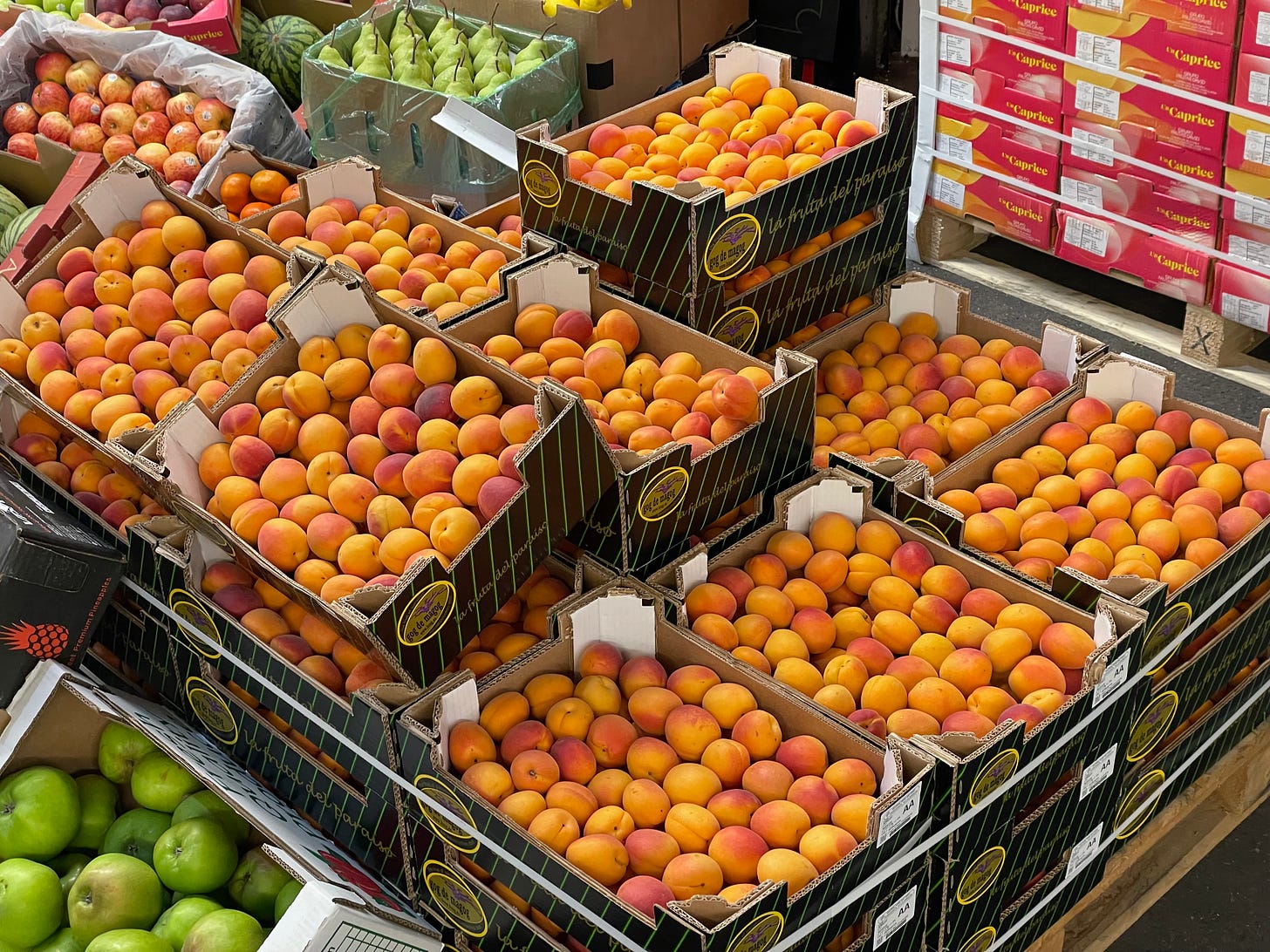

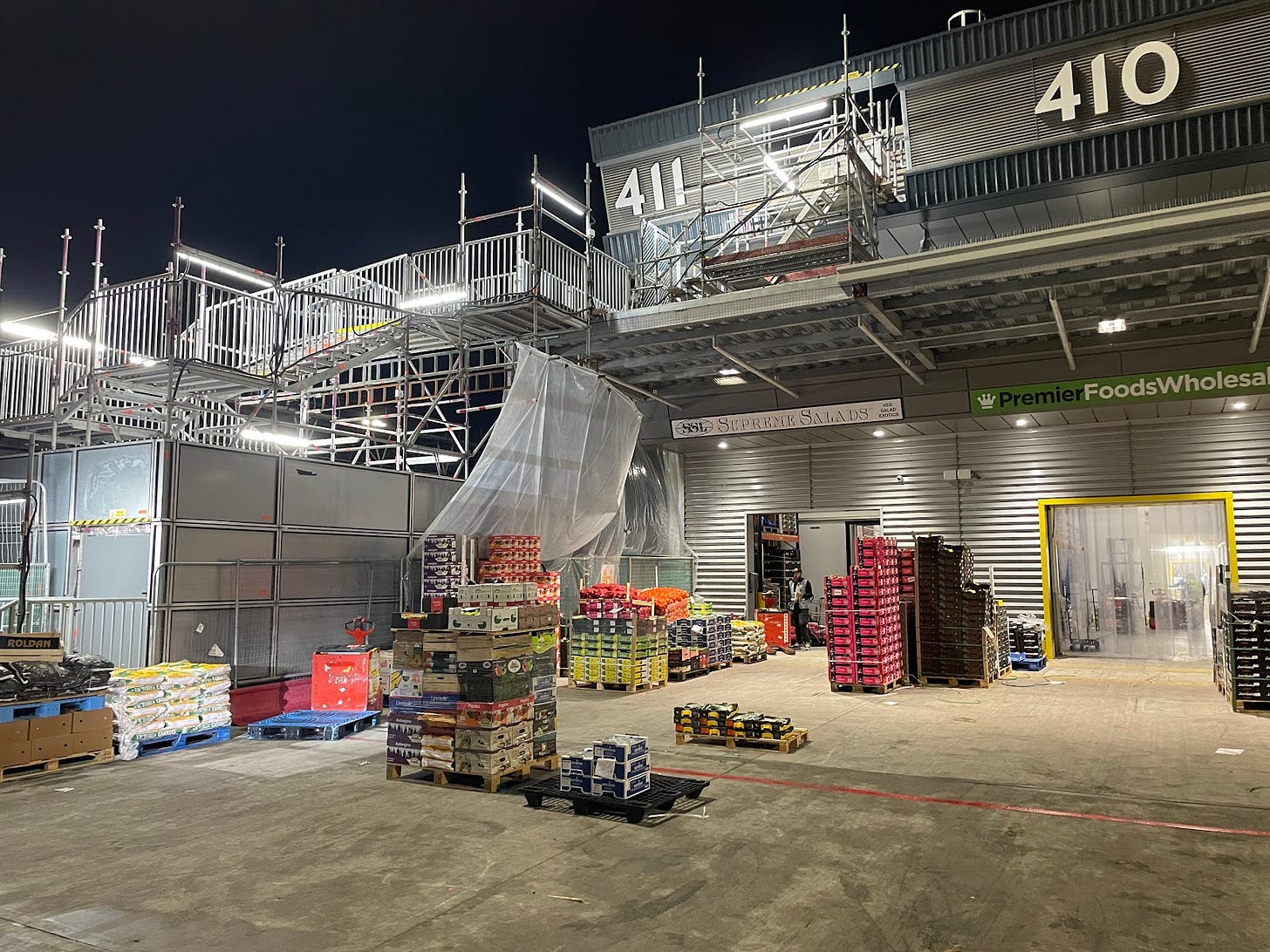


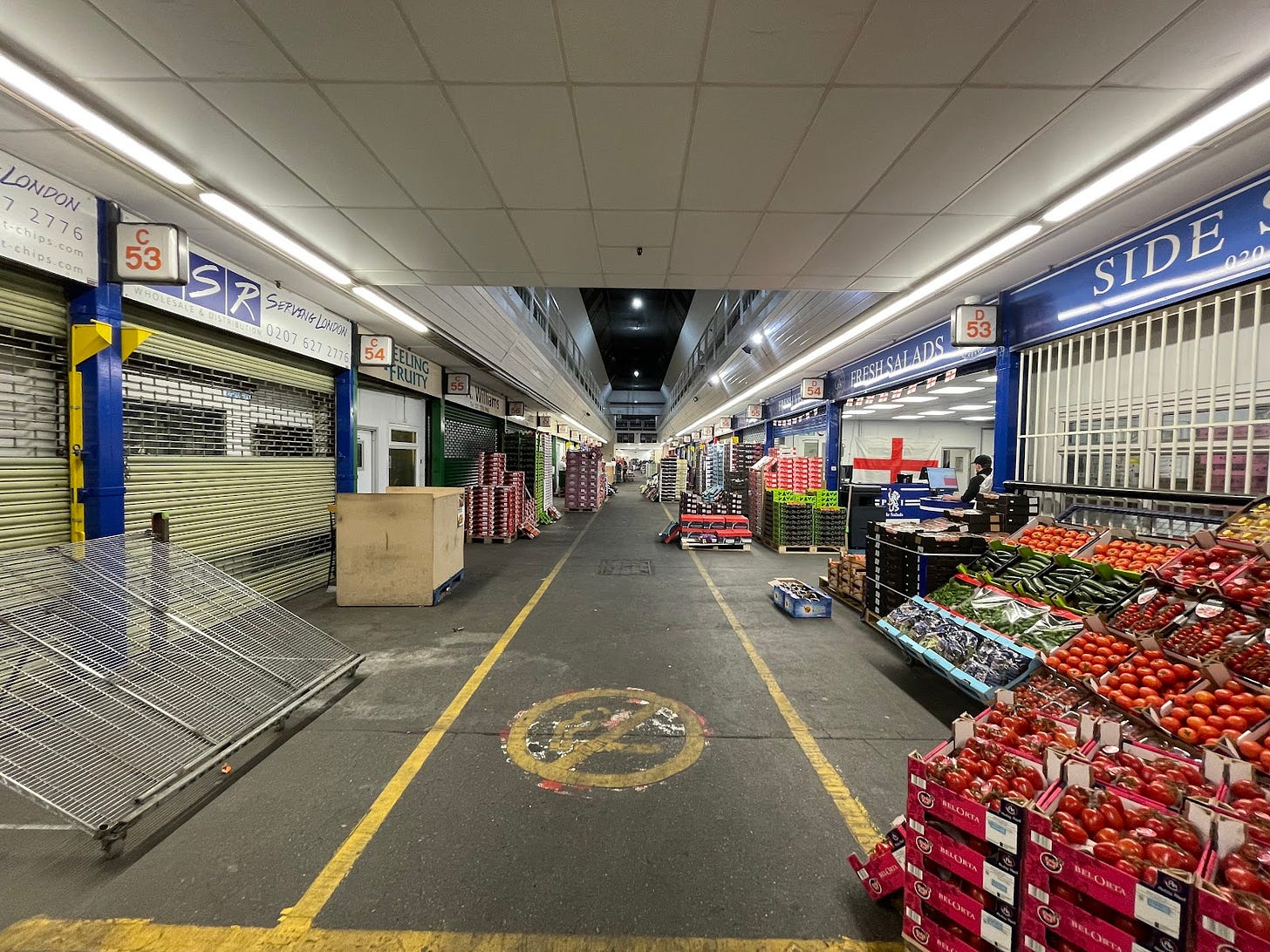
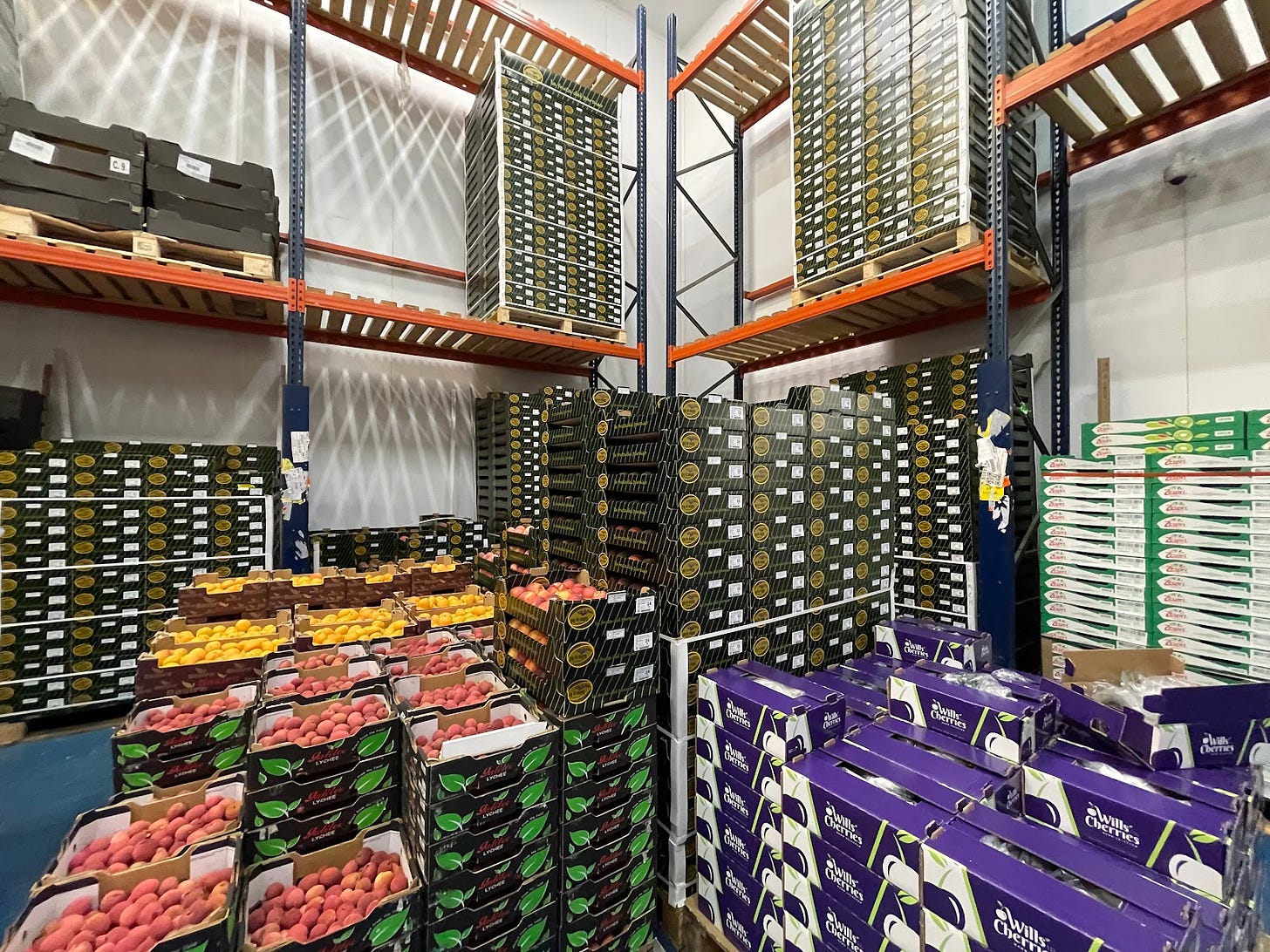

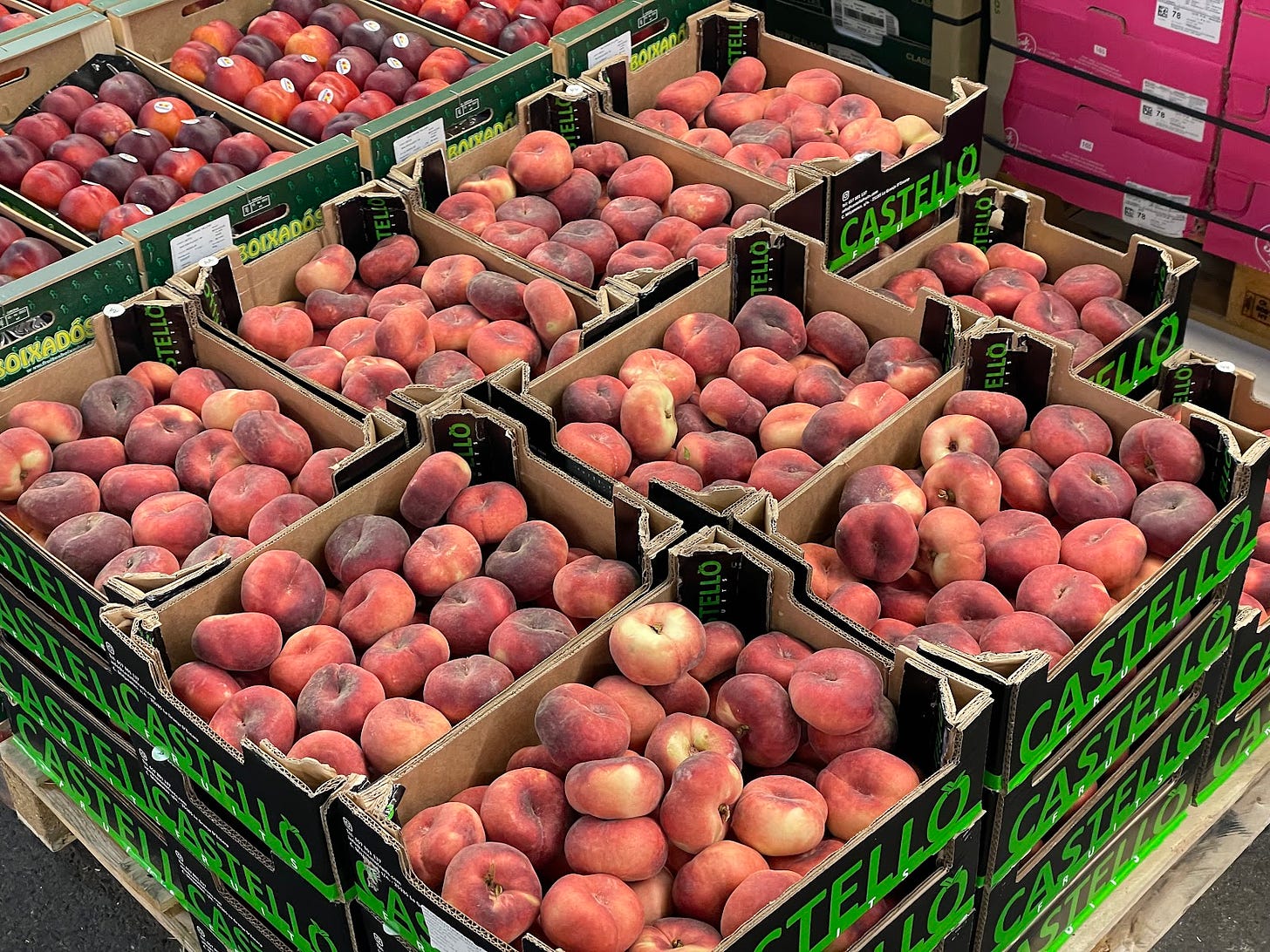

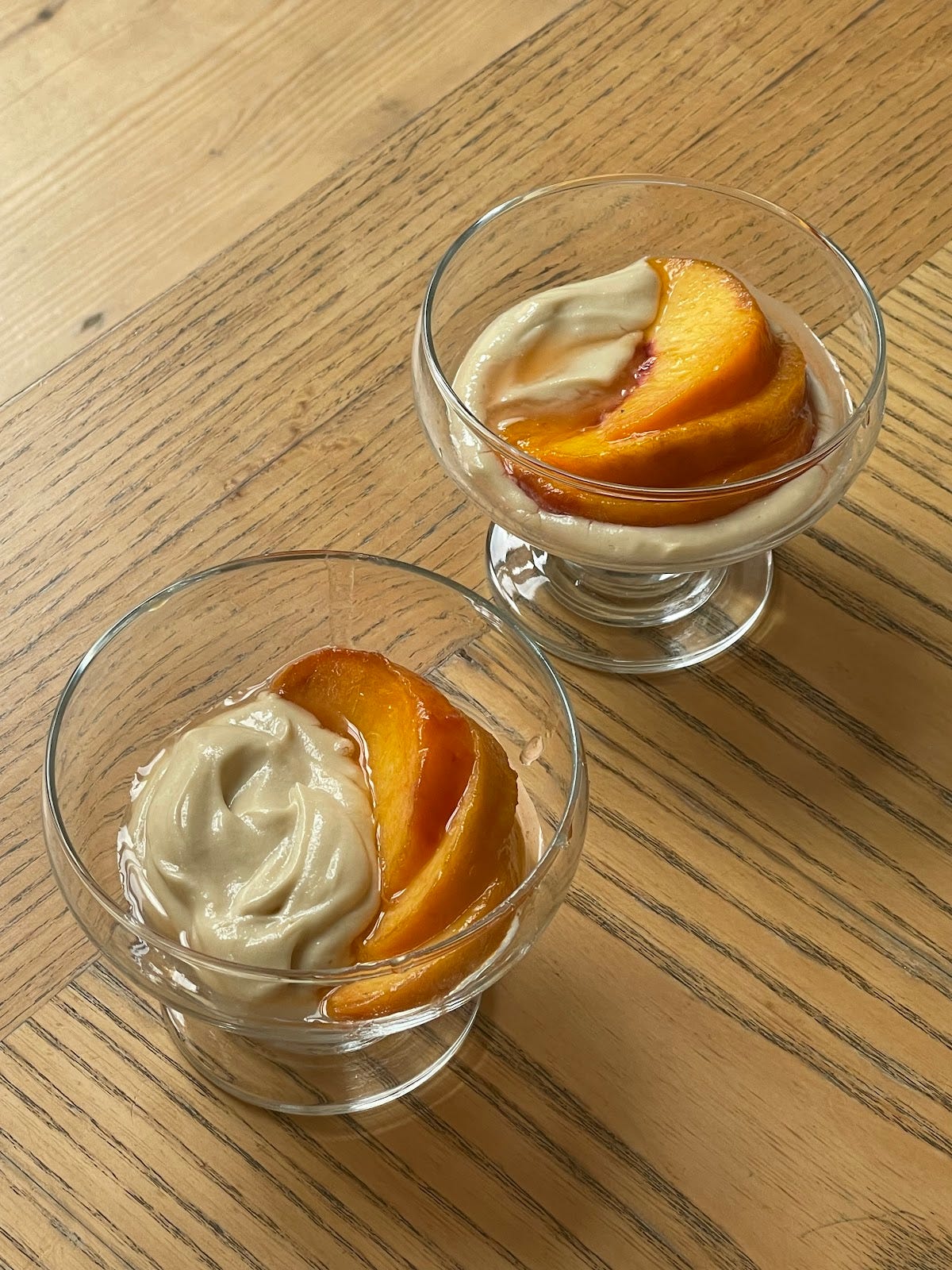

I also dream of a ripe peach! I remember when young hopping off the bus on my way to work there was a small greengrocer on my way and every year I couldn’t wait to see that box of ripe Italian peaches. One bite of the peach flesh and the juice would dribble down my chin! That is so rare these days.
This was a great read thank you.